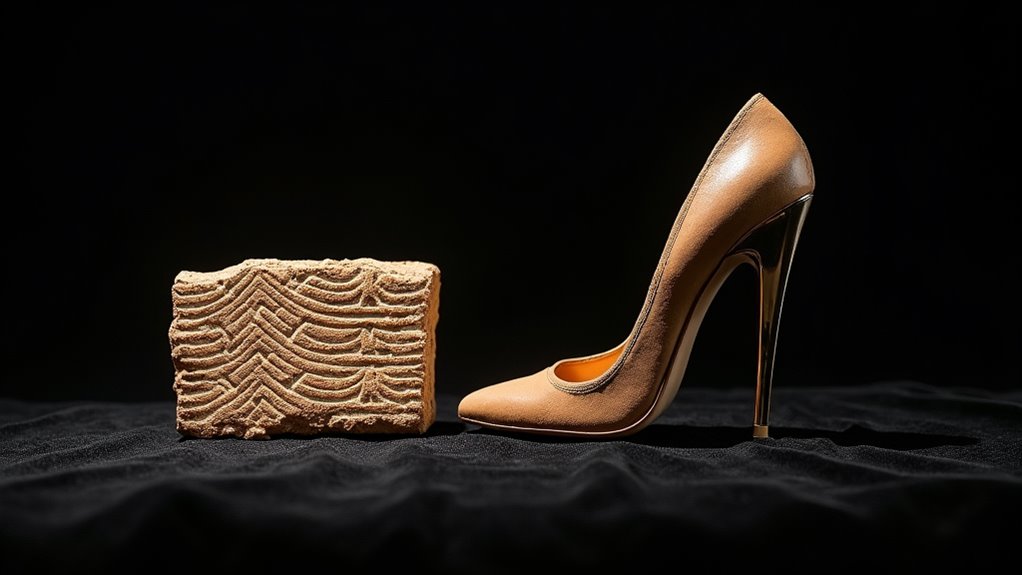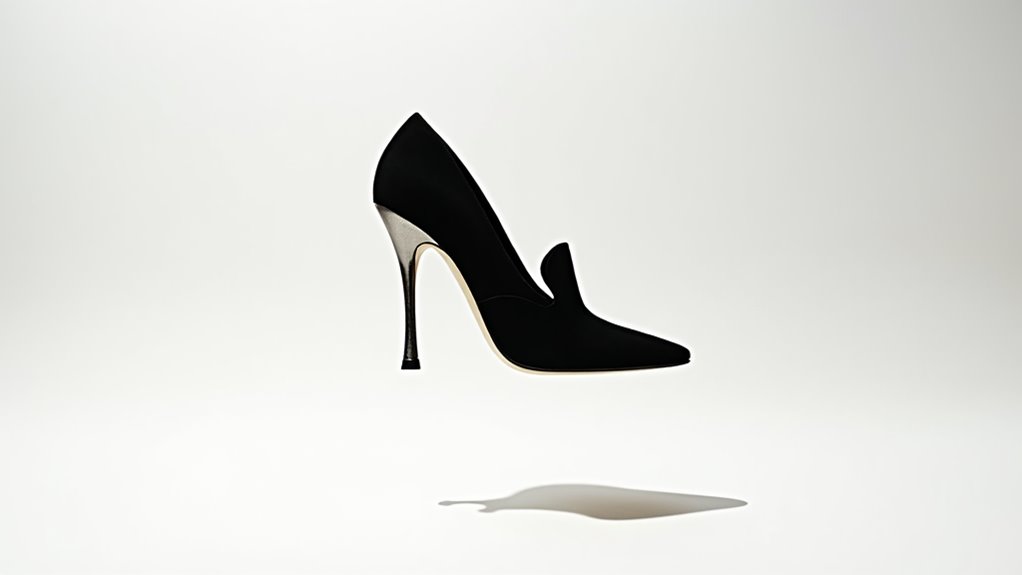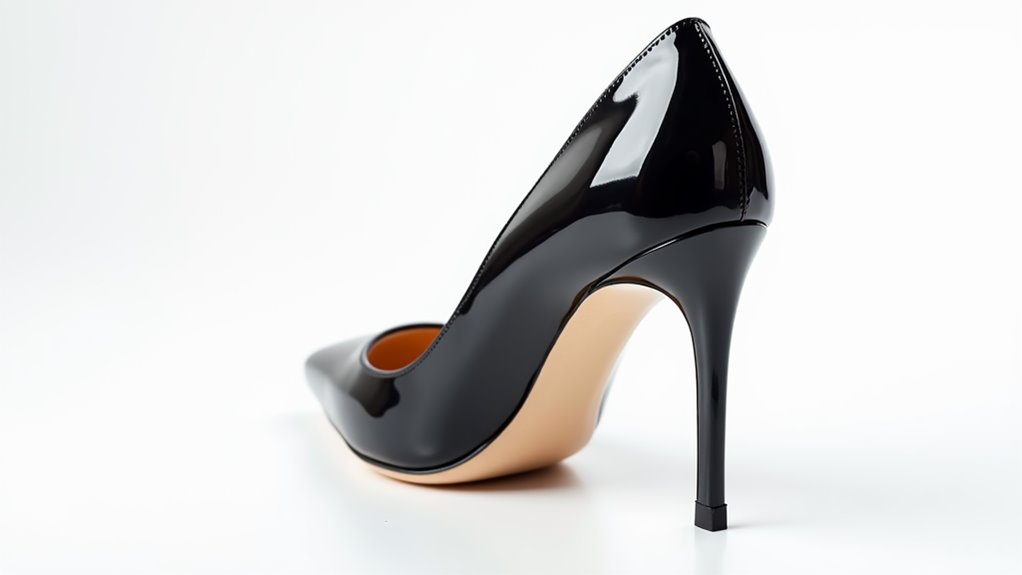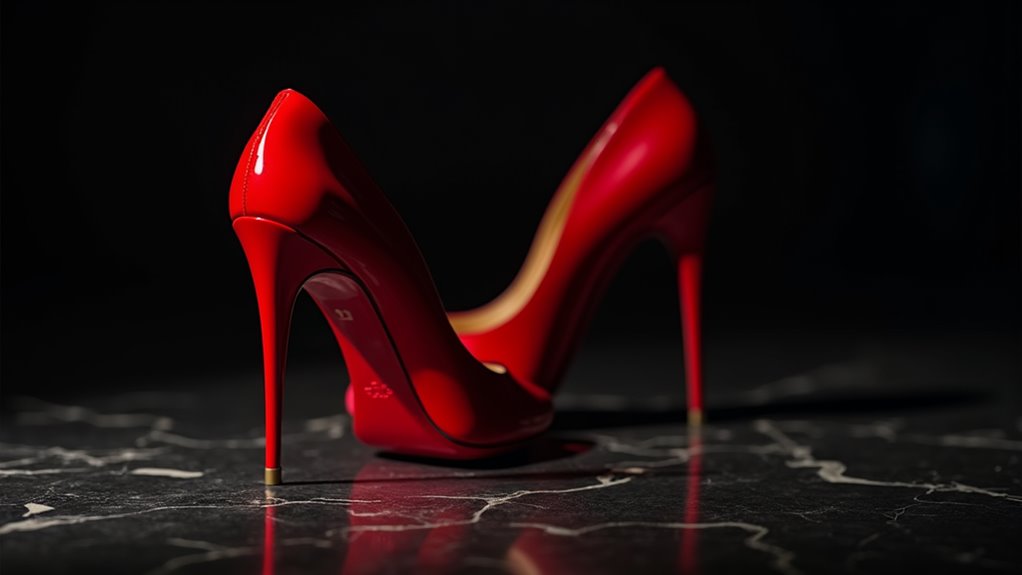There may be products. Products are independently selected by our editors. We may earn an affiliate commission from the links with no charge to you, example: as Amazon Affiliate.
We can trace the stiletto’s fascinating evolution from its ancient Roman origins as an engraving tool called “stilus” through its medieval transformation into a weapon and ultimately to its post-WWII emergence as a fashion icon. The genius behind modern stilettos emerged when Salvatore Ferragamo revolutionized their design with steel-reinforced arches, making them both stable and elegant. Other masters like Roger Vivier and André Perugia further refined these creations, while Christian Louboutin’s signature red soles later redefined luxury branding. From engineering marvels to cultural symbols of femininity and power, the stiletto’s remarkable journey offers countless innovations worth exploring.
Key Takeaways
- Salvatore Ferragamo revolutionized stilettos by introducing steel arch support, combining comfort with style in an unprecedented way.
- The stiletto’s evolution from ancient Roman engraving tool to fashion icon demonstrates remarkable design adaptability across centuries.
- Post-WWII engineering innovations enabled the creation of delicate yet durable stilettos through advanced manufacturing techniques.
- Roger Vivier and André Perugia’s early design contributions laid the foundation for modern iconic stiletto styles.
- Modern stiletto designs utilize precise biomechanical principles and advanced materials to optimize comfort while maintaining elegant aesthetics.
The Ancient Origins

Tracing its origins to Ancient Rome, the stiletto began as a “stilus” – a sharp, pointed knife used for intricate engraving work. We can observe how this utilitarian tool’s design perfectly matched its purpose, featuring a slender, penetrating blade that allowed for precise control during detailed tasks.
As we follow the stiletto’s history through time, we see its remarkable evolution from the 15th century onward. The tool’s sharp design proved versatile enough for various applications, from cleaning cannon barrels to taking measurements. What’s particularly fascinating is how societal changes gradually transformed this practical implement into something more complex. The stiletto’s repurposing reflects the shifting needs and values of different eras.
We can’t overlook how the tool’s origins influenced its later iterations. While its basic design remained true to its ancient roots, the stiletto’s journey from utilitarian implement to fashion accessory represents one of history’s most intriguing transformations. Its adaptability ultimately led to both practical applications and controversial uses, prompting various regions to regulate its possession due to its effectiveness as a concealed weapon.
Evolution Through Medieval Times
Throughout the Middle Ages, the stiletto knife evolved from its ancient Roman origins into a more specialized and notorious weapon. We can trace its development as a multi-functional tool, designed primarily for delivering the coup de grâce and maintaining artillery through tasks like cannon cleaning. The stiletto’s distinctive design, characterized by its sharp, slender point, embodied the perfect balance of utility and deadly efficiency.
By the 15th century, we see a significant shift in perceptions surrounding this weaponry. The stiletto’s adaptability made it particularly effective at penetrating heavy medieval clothing, but this same feature led to its association with treachery. Its compact size and ease of concealment transformed it from a practical tool into a symbol of deception during medieval times.
The evolution of the stiletto knife reflects broader sociocultural shifts in how society viewed weapons. We can observe how its design responded to changing needs while simultaneously shaping its reputation. This transformation from utilitarian implement to feared weapon demonstrates how medieval society’s complex relationship with concealed arms influenced both the practical and symbolic aspects of the stiletto’s development. The knife’s sleek, pointed form would later inspire modern fashion, particularly in glossy red heels that capture its elegant sophistication.
Post-War Fashion Revolution

We can trace the resurgence of feminine fashion to the post-World War II era, when women’s clothing shifted dramatically from utilitarian designs to more graceful silhouettes. Salvatore Ferragamo’s revolutionary steel arch innovation transformed the stiletto heel into a comfortable yet elegant accessory, merging technological advancement with high fashion. This fusion of style and engineering sparked a cultural transformation, as stilettos became powerful symbols of feminine confidence and modern sophistication in the rapidly evolving post-war society. Just as mountain gear essentials revolutionized outdoor adventures with their innovative designs, the stiletto heel revolutionized women’s fashion with its groundbreaking engineering.
Feminine Silhouettes Return
The post-war era ushered in a dramatic shift from austere, androgynous fashion to pronounced feminine silhouettes, with the stiletto heel emerging as a powerful symbol of this transformation. As we moved through the late 1940s, women’s fashion embraced a more vibrant and distinctly feminine aesthetic, marking a decisive break from wartime utility clothing.
Salvatore Ferragamo’s innovative contributions proved instrumental in this evolution. His introduction of the steel arch support revolutionized the stiletto design, making these ambitious heights both achievable and wearable. We can trace how the stiletto heel rapidly transformed from a novel design element into a luxury staple that defined post-war elegance.
What’s particularly fascinating is how multiple shoemakers claimed credit for the stiletto’s invention, underscoring its immense cultural impact. The design became more than just a fashion statement – it represented a broader shift in how we viewed femininity and empowerment in the post-war period. As women embraced these new silhouettes, the stiletto heel became an enduring symbol of confidence and sophistication, reflecting the era’s renewed appreciation for feminine grace and bold design.
Style Meets Technology
An unprecedented marriage of style and engineering marked the post-war fashion revolution, as innovative manufacturing techniques transformed how designers approached heel construction. We witnessed how technological advancements enabled master craftsmen like Salvatore Ferragamo to revolutionize women’s fashion through the introduction of steel-reinforced stiletto heels, perfectly balancing elegance with structural integrity.
The fusion of design innovation and engineering excellence created a new paradigm in shoemaking, establishing the stiletto as a luxury staple that would define feminine styles for generations to come.
| Designer | Innovation | Impact |
|---|---|---|
| Ferragamo | Steel arch support | Enhanced stability |
| Vivier | Needle heel design | Ultimate elegance |
| Perugia | Sculptural approach | Artistic evolution |
As we examine this transformative period, we can’t overlook how these technological breakthroughs elevated stiletto heels to iconic status. The competitive spirit among leading designers drove continuous improvements in both form and function, resulting in creations that masterfully combined sophisticated aesthetics with practical wearability. This era’s legacy lives on in contemporary craftsmanship, where cutting-edge technology continues to enhance traditional shoemaking techniques.
Masters of Stiletto Design
We can trace the stiletto’s most significant engineering breakthrough to Salvatore Ferragamo’s innovative steel arch support, which transformed high heels into more wearable fashion statements after World War II. While Roger Vivier and André Perugia made notable contributions to early stiletto development, Ferragamo’s metal reinforcement technique became the industry standard, allowing for increasingly daring heel heights without sacrificing stability. Today’s iconic stiletto designs, including Christian Louboutin’s signature red soles, build upon these foundational innovations while continuing to push the boundaries of both form and function.
Ferragamo’s Revolutionary Steel Support
Among the most influential innovations in stiletto design, Salvatore Ferragamo’s integration of steel arch support stands as a watershed moment in footwear history. By introducing this revolutionary steel support system, Ferragamo transformed the stiletto from a purely aesthetic accessory into a masterpiece of engineering that balanced both form and function.
We can’t overstate the significance of this innovation in the post-World War II era, when women increasingly demanded footwear that combined elegance with comfort. Ferragamo’s design addressed this need by incorporating a steel arch that distributed weight more evenly, allowing for greater heel heights without sacrificing wearability. This breakthrough in functionality set new industry standards and influenced countless designers who followed.
What’s particularly remarkable about Ferragamo’s contribution is how it elevated the stiletto beyond mere fashion. His emphasis on both design and comfort helped establish the stiletto as a symbol of femininity and empowerment. The perfect marriage of aesthetic appeal and practical engineering continues to influence modern footwear design, proving that Ferragamo’s innovation wasn’t just about creating beautiful shoes—it was about revolutionizing how we think about fashion and functionality.
Louboutin’s Red Sole Legacy
While Ferragamo revolutionized stiletto engineering, Christian Louboutin transformed the aesthetic landscape of luxury footwear with a single stroke of red nail polish in 1992. What started as an impromptu experiment with his assistant’s nail polish became fashion’s most recognizable signature element, establishing a global empire built on a flash of crimson.
| Evolution of the Red Sole | Impact on Fashion |
|---|---|
| 1992: First red sole created | Instant recognition |
| Early 90s: Black fashion contrast | Status symbol emergence |
| Mid 90s: Design protection | Luxury market dominance |
| Present: Cultural icon | Global brand identity |
We can’t underestimate how this designer’s innovative approach redefined luxury footwear. The red sole’s power lies in its ability to serve as an instant symbol of status, passion, and sophistication. In an era when fashion houses struggled to maintain distinctive identities, Louboutin created an iconic marker that transcended traditional branding. Today, the red sole stands as more than just a design element – it represents a cultural phenomenon that continues to influence both high fashion and popular culture, cementing Christian Louboutin’s legacy in the annals of fashion history.
Engineering Behind the Height

The engineering brilliance behind stiletto heels stems from post-World War II manufacturing advances that revolutionized shoe design. When we examine the evolution of these iconic high heels, we’ll find that their slender structure was made possible through innovative production techniques that allowed for more delicate yet durable construction.
We can trace a significant breakthrough to Salvatore Ferragamo’s introduction of the steel arch support system. This engineering marvel transformed what could have been an unstable design into a wearable work of art. The precise angle of elevation isn’t just for show – it’s carefully calculated to enhance the wearer’s posture while creating that coveted leg-lengthening effect.
Today’s stiletto design incorporates sophisticated biomechanics research and modern materials like thermoplastic polyurethane. We’re seeing remarkable improvements in how these shoes distribute weight across the foot, significantly enhancing comfort without sacrificing the elegant silhouette. Engineers now approach stiletto design with a deep understanding of foot mechanics, creating heels that maintain their iconic status while providing better support through scientific weight distribution principles. Many wearers find that adding quality heel inserts can further enhance the comfort and stability of their stilettos.
Red Soles and Luxury
From pure functionality to iconic branding, stiletto heels took a revolutionary turn in 1992 when Christian Louboutin’s creative inspiration struck during a routine design session. While examining a prototype, the designer noticed his assistant’s red nail polish and decided to paint the soles, transforming luxury footwear forever. The red soles quickly became more than just a design element; they evolved into a powerful symbol of sophistication and status.
We’ve witnessed how Louboutin’s craftsmanship and attention to detail elevated this simple color choice into a global phenomenon. The red sole’s impact on pop-culture and fashion can be measured through these significant achievements:
- Created an instantly recognizable symbol of luxury that transcends language barriers
- Established a new standard for designer footwear branding and recognition
- Generated a powerful association with passion, confidence, and prestige
- Sparked a revolution in how fashion houses approach distinctive design elements
Today, we understand that the iconic red soles represent more than just a designer’s creative whim. They embody the perfect fusion of artistry and innovation, demonstrating how a single design element can capture the essence of luxury and transform it into a timeless statement of style. Modern consumers can now choose sustainable heel alternatives that maintain the elegance of classic stilettos while promoting eco-conscious fashion.
Cultural Impact and Status

Throughout modern fashion history, stiletto heels have transcended their role as mere accessories to become powerful cultural symbols of status, femininity, and empowerment. From their post-war emergence, we’ve witnessed these iconic shoes evolve from practical footwear to a luxury staple that defines contemporary fashion’s highest echelons.
We can trace stiletto heels’ cultural legacy through their consistent presence in haute couture and their influence on societal standards of beauty. They’ve become more than just fashion items – they’re statements of elegance and self-expression that challenge and reshape our understanding of power dynamics in the fashion industry. As we’ve observed their evolution, stilettos have maintained their allure despite shifting trends, with their iconic status reinforced by celebrity endorsements and runway appearances.
What’s particularly fascinating is how stiletto heels continue to spark conversations about femininity and empowerment. They’ve become a canvas for exploring identity and challenging traditional gender norms, while simultaneously embodying sophistication and allure. Their enduring presence in fashion speaks to their remarkable ability to adapt and remain relevant, reflecting broader cultural shifts in how we view power, status, and personal expression. The incorporation of formal embellished designs has elevated stilettos from basic footwear to intricate works of wearable art.
Modern Interpretations and Innovation
Modern interpretations of the stiletto design have revolutionized fashion’s landscape, as designers push boundaries by merging traditional elements with innovative concepts. We’re witnessing a remarkable transformation in how the stiletto’s iconic silhouette adapts to contemporary needs while maintaining its essence of empowerment and self-expression.
Consider these groundbreaking innovations:
- SYRO STILETTO Shoulder Bag’s unique fusion of footwear technology with functional accessories
- Lucila Safdie’s “Farewell Princess” collection exploring dual aspects of modern womanhood
- LOEWE’s artistic vision incorporating natural elements and innovative design techniques
- Collaborative craftsmanship celebrating the queer community’s influence on fashion
The evolution of stiletto-inspired design represents more than aesthetic changes; it’s a powerful statement about identity and cultural transformation. Through these modern interpretations, we’re seeing unprecedented creativity in how designers approach traditional forms. The integration of footwear technology with accessory design, as exemplified by the STILETTO Shoulder Bag, demonstrates how innovation can challenge conventional fashion boundaries while creating meaningful dialogue about representation and identity in contemporary society. Eco-friendly materials are increasingly shaping modern stiletto designs, offering conscious consumers stylish alternatives that align with sustainable fashion values.
Conclusion
Isn’t it remarkable that we’ve traced the stiletto’s journey from ancient Egypt to today’s tech-enhanced designs? We’ve witnessed how this architectural marvel transformed from practical footwear into a symbol of power and prestige. Like the modern skyscraper, which shares the same engineering principles of load distribution and balance, the stiletto continues to evolve. Yet its essence remains unchanged: the perfect fusion of art and engineering.
